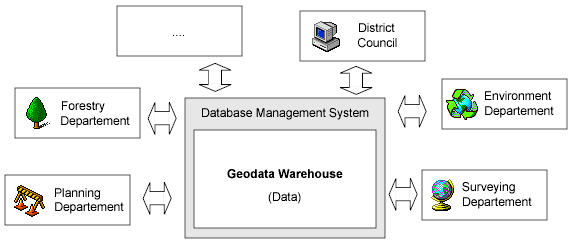Central Geodata Warehouse
Recently it has become more common in city and canton governments to manage and update spatial data of all parts of the government
in one central data pool called geodata warehouse (a spatial database management system). This makes huge savings as the data
is now stored redundance free and needs to be updated only once. Until now, some data needed to be stored and updated in different
departements of the government. This made it enormously difficult to have current data in all places. Additionally, when doing
bigger projects the data can now simply be taken out of the geodata pool and does not need to be gathered in tedious and lengthy
work.
The most important characteristics of such database systems:
|
Concurrent
Use
|
A central geodata warehouse is a nice example of concurrent use of a database system. On the one hand different users get
their data from it - the employees of the different departements. On the other hand different application software (e.g. GIS
system) are used to access the geodata warehouse. Therefore, it is possible that the forestry departement uses GIS software
A for access to the data while the surveyor departement uses GIS software B.
|
|
Separation of
Data and Applications
|
As described above, different users’ with different applications get access to the data. This is only possible, if the data
is separated from the applications. If data were connected to the application it would be much work to process the data in
way that other applications could read and use it. This independence is especially important in cases where the DBMS software
needs replacement. With the separation of data and applications this is possible without having to re-write all of the application
software.
Example: A Microsoft Word file (where the data is included in the application format) is quite difficult to open with the
Microsoft Excel software even though both applications are made by the same company.
|
|
Data
Persistence
|
The capture of  geodata: and other data is most often a lot of work and very expensive. Therefore, data persistence is a very important characteristic
of a geodata warehouse. This way, it is possible to ensure that data is not lost and needs then to be replaced, which is costly. geodata: and other data is most often a lot of work and very expensive. Therefore, data persistence is a very important characteristic
of a geodata warehouse. This way, it is possible to ensure that data is not lost and needs then to be replaced, which is costly.
|
|
Data Integrity
|
Governmental data often give information about legal conditions for example, the cadaster. Therefore, these data need to be
thoroughly correct and reliable. That is achieved through the definition and following of specific consistency requirements
and rules.
|
 Schematic Representation of a Geodata Warehouse and the possible Access to it from different Offices
Schematic Representation of a Geodata Warehouse and the possible Access to it from different Offices